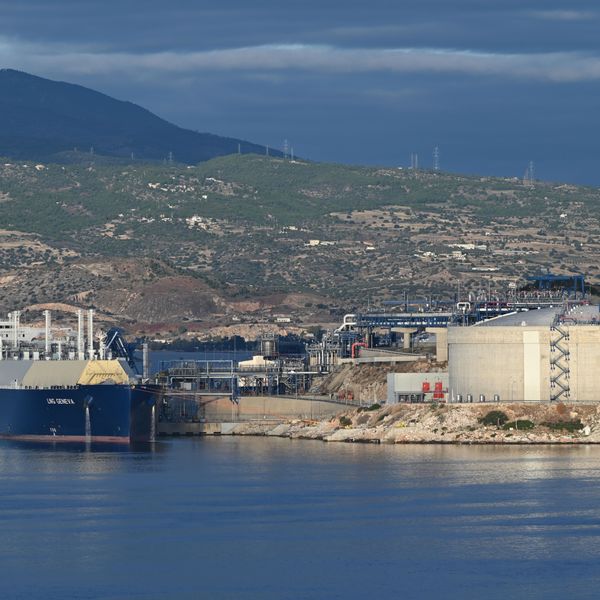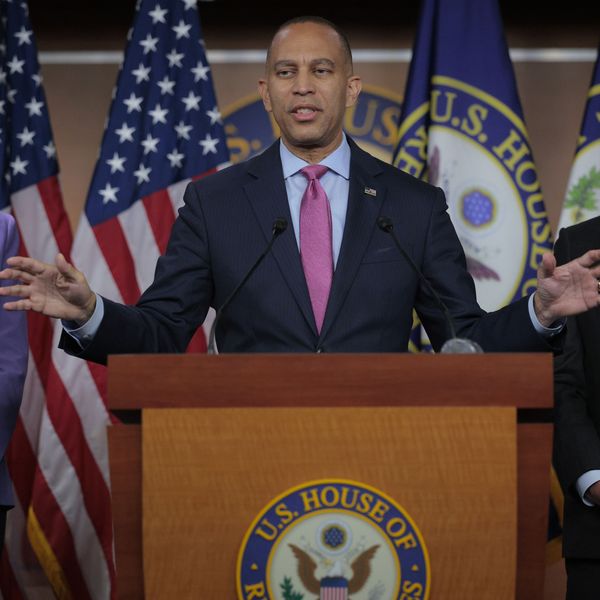As the United States ramps up clean energy production, the growing recognition that the nation's electricity grid currently lacks the capacity required to fully integrate renewables has prompted calls from across the political spectrum for so-called "permitting reforms" that proponents say are necessary to expedite the construction of transmission lines and related infrastructure.
On Thursday, a coalition of environmental justice groups staunchly opposed to those calls—on the grounds that the reforms proposed so far amount to discarding hard-won regulations—published a white paper outlining how to "address the transmission bottleneck and rapidly scale up infrastructure that advances an equitable clean energy future... while preventing harm to impacted communities and without eroding bedrock environmental protections."
The new blueprint for a just acceleration of transmission capacity was developed by WE ACT for Environmental Justice, Earthjustice, Environmental Defense Fund, Center for American Progress, League of Conservation Voters, National Hispanic Medical Association, Natural Resources Defense Council, Sierra Club, and Union of Concerned Scientists.
Building on principles the nine groups released in December, the white paper provides "clear, actionable steps for policymakers," including some "that can be implemented under existing legal authorities and others that require legislative action."
Before recommending solutions, the coalition spells out the problem:
To accelerate the essential transition from fossil fuel-fired power plants to renewable energy, we need to build more transmission to move clean energy across the country in addition to scaling up local, distributed clean energy resources. Transmission is also critical to ensuring grid reliability and resilience, particularly as we face extreme weather events caused by climate change.
However, we are not building transmission at the pace and scale needed today: The current annual growth rate of transmission infrastructure is just 1%. The result is a backlog of roughly 8,000 generators waiting to connect to the grid and significant uncertainty for clean energy developers about whether and when their projects will be able to provide power to homes and businesses. The transmission bottleneck leaves huge climate benefits on the table, including those made possible through the Inflation Reduction Act. To fully realize the IRA's emissions reductions benefits and transition to a clean grid, we need to at least double current transmission capacity by the end of this pivotal decade.
The problem has also been detailed by The Washington Post in December and by the National Bureau of Economic Research in a working paper published this month. Even though rapidly "electrifying everything" and cleaning up electricity by replacing coal, oil, and gas with wind, solar, and other carbon-free energy sources is key to averting the worst consequences of the climate crisis, insufficient transmission capacity is leading to "interconnection queues," increasing the "curtailment"—or temporary dropping from the grid—of power supplied by renewables, and otherwise hindering lifesaving decarbonization efforts.
A wide range of political actors have endorsed the need for so-called "permitting reform." Not all of them are champions of green energy generation. For instance, congressional Republicans and right-wing Democratic Sen. Joe Manchin (D-W.Va.) have pushed to weaken rules around building infrastructure of all kinds because the fossil fuel industry they are beholden to stands to benefit from deregulation.
"Urgency cannot become a pretext for gutting the requirements of environmental review and public engagement as we embark on what could be the greatest U.S. infrastructure build-out in nearly a century."
But even some clean energy advocates have argued that "environmental laws are used to kill climate-friendly development," as University of California Davis law professor Chris Elmendorf put it earlier this year in Mother Jones. Meanwhile, Democratic California Gov. Gavin Newsom—currently embroiled in a fight with progressive activists who warn that his proposal to expedite the construction of green infrastructure ignores the need for democratic deliberation and transparency—recently told The New York Times' Ezra Klein that "we need to build. You can't be serious about climate and the environment without reforming permitting and procurement in this state."
The coalition agrees that "we urgently need policy reform," stating in its white paper: "We need to modify and improve the rules of the road for planning, paying for, and siting transmission. And we need to create a federal pathway for siting transmission lines that are essential to bringing new renewable generators online."
However, "we must also reject the false choice between quickly ramping up transmission and protecting communities from harmful permitting decisions," the paper continues. "Urgency cannot become a pretext for gutting the requirements of environmental review and public engagement as we embark on what could be the greatest U.S. infrastructure build-out in nearly a century. To build transmission faster and more fairly, we need smart reforms that target the drivers of the transmission bottleneck while preserving critical environmental, health, and community protections and enhancing community engagement."
The "smart reforms" identified in the coalition's roadmap include:
- The Federal Energy Regulation Commission (FERC) must finalize strong transmission
planning and interconnection rules to
address transmission needs, maximize
consumer benefits, and ensure meaningful
opportunities for community engagement;
- FERC must establish environmental justice liaisons to support consultation and planning in environmental justice communities and tribal nations;
- FERC must require interregional transmission planning;
- The U.S. Department of Energy and FERC should leverage the National Interest Electric Transmission Corridor designation process and backstop siting provisions recently strengthened by the Infrastructure Investment and Jobs Act in order to site certain high-priority transmission lines;
- Congress should amend the Federal Power Act (FPA) to give FERC the authority to site large-scale interstate transmission projects that meet certain requirements; and
- Congress should amend the FPA to allow FERC to better assess the multiple benefits associated with a transmission project.
"To cut emissions and save lives, we need to shift swiftly and equitably to a 100% clean electricity grid," Jill Tauber, vice president of litigation for climate and energy at Earthjustice, said in a statement. "Transmission plays a key role in this essential transition, but we face serious barriers to building clean energy infrastructure at the speed and scale needed."
"The key reforms outlined in this paper—many of which the federal government can implement today—will help build the backbone of a zero-emissions economy, while preserving and strengthening community and environmental protections," said Tauber. "We must do both to build a clean energy future that leaves no one behind."
Tauber's sentiment was echoed by Jasmine Jennings, an attorney at WE ACT for Environmental Justice.
"We must build infrastructure necessary to transmit clean, renewable energy and transition beyond dirty, polluting fossil fuel infrastructure," said Jennings. "It is equally important that the build-out is just, equitable, and sustainable and that communities are not harmed in the process."
"Early and ongoing engagement with impacted communities, increased grid reliability and resilience, sustainable pathways for interregional transmission projects, and cost allocation are key to this transition," Jennings added. "As we envision a clean energy future, we must actively ensure that the build-out sacrifices none and serves all."



